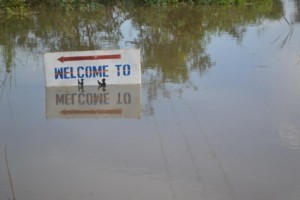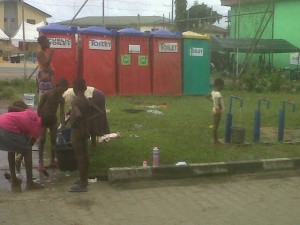As the flood that ravaged the entire Bayelsa State finally recedes, many of the Internally Displaced Persons (IDPs) were contemplating on how to live their lives after the flood. While many of them left voluntarily for fishing and farming activities, others waited for government support for proper resettlement.

This, however, was not the case as the Bayelsa State Government, through the State Flood Management Committee, forcefully ordered the evacuation of all IDPs from all the various camps in the state.
Stern-looking police officers as well as members of the Joint Task Force (JTF) were stationed at the various camps to forestall any resistance from the flood victims.
“Most of us in our villages the houses have fallen down, so no where to stay; no food to eat and no money to start a new life, the government should have at least assisted us to start a new life,” one of the flood victims who identified himself as Ebidou said.
With over 2,000 communities in all the eight Local Government Areas (LGAs) as well as over 10,000 homes submerged by the flood including the home of President Goodluck Jonathan in Otuoke, many of the elderly and the pregnant women were also forced out of the relief camps and transported back to their unhealthy homes.
“Now, they want to force us to leave this place, as I am going home now I don’t have any money in my pocket. My tears shall fall on those that are doing us these things,” a 70-year-old man, Pa Ezekiel, laments.
According to the state government, the evacuation was informed by the need to allow proper resumption of academic activities in the state. Government spokesman, Markson Fefegha, noted that the present administration places a very high premium on education, adding that the call to ask IDPs to leave the relief camps is also hinged on the fact that government needs to renovate the schools.

In a statement, Fefegha stated further that government had observed that a lot of nocturnal meetings ere being held across the various camps, thereby posing security threat to the administration.
Fefegha disclosed that government hads begun the process of supporting all IDPs returning home with transport fares and supplies, “just as government will identify public facilities affected by the flood, with a view to renovating them,” he added.
Bayelsa is a lowland state characterised by tidal flats and flood plains. It is a picturesque tropical rain forest, with an area of about 21,110 square kilometers. More than three quarters of this area is covered by water, with a moderately low land stretching from Ekeremor to Nembe and lying almost entirely below sea level with a maze of meandering creeks and mangrove swamps.
Like any other state in the Niger Delta region, the vegetation of Bayelsa State is composed of ecological mangrove forest and fresh water swamp. These vegetation types are associated with the various soil units in the area and they constitute part of the complex Niger Delta ecosystems. Parts of the fresh water swamp forests in the state constitute the home of several threatened and even endangered plant and animal species.
Bayelsa State lies within the heavy rainfall belt in Nigeria, so it rains for a better part of the year, with just a dry season running from November to April. There is a network of several creeks and rivers in the south, leading into the Atlantic Ocean via the major rivers.
By Oyins Egrenbido

Hello and thank you for this article. So-called environmentally induced migration is multi-level problem. According to Essam El-Hinnawi definition form 1985 environmental refugees as those people who have been forced to leave their traditional habitat, temporarily or permanently, because of a marked environmental disruption (natural or triggered by people) that jeopardised their existence and/or seriously affected the quality of their life. The fundamental distinction between `environmental migrants` and `environmental refugees` is a standpoint of contemporsry studies in EDPs.
According to Bogumil Terminski it seems reasonable to distinguish the general category of environmental migrants from the more specific (subordinate to it) category of environmentally-induced displaced people.
According to Norman Myers environmental refugees are “people who can no longer gain a secure livelihood in their homelands because of drought, soil erosion, desertification, deforestation and other environmental problems, together with associated problems of population pressures and profound poverty”.